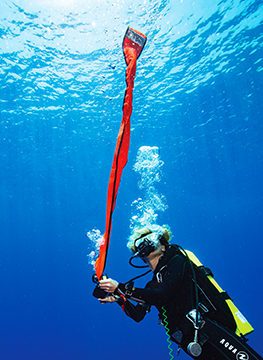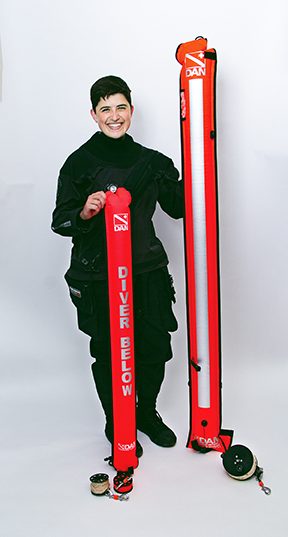SURFACE MARKER BUOYS (SMBS) AND DELAYED SURFACE MARKER BUOYS (DSMBS) are common and essential safety devices. These brightly colored, inflatable tubes, sometimes called safety sausages, are critical pieces of equipment that divers should take on most dives. Divers most often use them as signaling devices to mark their locations below the surface and alert boat traffic. Technical divers may use a DSMB as an upline to fulfill their decompression obligations. Rescuers might deploy them in the event of a distressed diver, like how a lifeguard would use a rescue tube on the surface. There are several myths and misconceptions about DSMBs, and many divers use them improperly and ineffectively.
TERMINOLOGY
A DSMB is technically an SMB, but an SMB is not a DSMB. Divers can deploy a DSMB on the surface or from depth thanks to an over-pressurization valve (OPV). This valve allows air to escape and relieves the gas that expands, according to Boyle’s Law. An SMB’s design, which lacks an OPV, means it should be inflated only at the surface. If you deploy an SMB from depth, it will sustain physical damage from overexpansion as it ascends. This article will refer to DSMBs as their applications and features are more extensive than their SMB counterparts.
SPECIFICATIONS
DSMBs are available in various sizes, shapes, and colors — some are more practical than others. A 4-foot DSMB is sufficient for divers to learn the deployment techniques for training purposes. Outside of a training environment, divers should use at minimum a 6-foot DSMB, which provides better visibility to surface support and other boats, especially in unfavorable seas with large swells. It also offers sufficient lift to avoid being dragged underwater while the diver is ascending.
Orange and yellow are the most common colors and offer the best visibility, but there is no industry-standard color. DSMBs are also available in pink, white, green, and even black, but some colors are not as easy to see on the surface due to reflection and blending in under certain daytime conditions. Some manufacturers add reflective strips and a thin, clear sleeve at the top to accommodate a strobe or chem-light for deployment in low light conditions.
Some divers designate specific DSMB colors to communicate different messages to surface support personnel. This practice is most common in technical diving. For example, an orange DSMB may communicate that all divers are accounted for and okay, and a yellow DSMB may communicate some emergency. A slate or an underwater notebook page attached to the yellow DSMB can specify the problem and describe the required intervention measures from surface support. Of course, this system only works if all divers agree upon one predefined plan. Regardless of the color, all divers should consider writing their names in large letters on their DSMBs so surface support can more easily identify the diver below.
TECHNIQUES
Some divers are adamant about using a reel instead of a spool or vice-versa. Divers should weigh the pros and cons of each and decide based on their personal diving needs. Each has its advantages — a reel is easier to deploy, but a spool is more difficult to jam.
Divers also debate whether to permanently attach (pre-rig) a spool or reel to the DSMB to ready it for rapid deployment or leave it to assemble underwater. Should a diver clip the DSMB directly onto their BCD or store it in a pocket or pouch? Every diver should evaluate their needs and decide which option is the most practical for all these considerations.
There are strong opinions about inflating a DSMB. Should you orally inflate it? What about exhaling from your second stage or purging the octopus into the open bottom? How about attaching a low-pressure inflator from a drysuit or BCD? All methods are viable with proper training and regular practice.
SAFETY CONSIDERATIONS
There are a few universal safety concerns to address whenever using a DSMB. Divers should never clip the reel or spool to themselves during deployment because if it jams, the excess buoyancy could cause a rapid ascent. If you clip the reel or spool after the DSMB is already on the surface, a passing boat or curious topside passerby could yank the line, again causing a rapid ascent.
Throughout deploying a DSMB, remember that slow is smooth, and smooth is fast. Divers should keep all lines taut and as far away from their bodies as possible. Maintaining this distance will decrease the likelihood of entanglement. If there is excess slack in the line, take a moment to resolve it. Issues can compound quickly, and the line is unforgiving if a diver becomes entangled.
Divers should have an easily accessible cutting device available every time they deploy a DSMB. If possible, a dive buddy should be nearby to intervene in the event of a failed or disrupted deployment.
Most important, divers must practice. Becoming proficient at deploying a DSMB takes time. Go to a local pool or other confined water location with your buddy and practice each step of the process, identifying areas of deficiency. Ask instructors and mentors for help. Do not be afraid of failure, as that is how learning and muscle memory occurs. At the end of every dive, consider deploying a DSMB. Repetition creates proficiency and comfort with a skill that every diver should possess. AD

DSMBs can help surface support personnel and other boats locate divers on the surface.

A DSMB at least 6 feet long will help ensure sufficient visibility.
© Alert Diver — Q3 2022